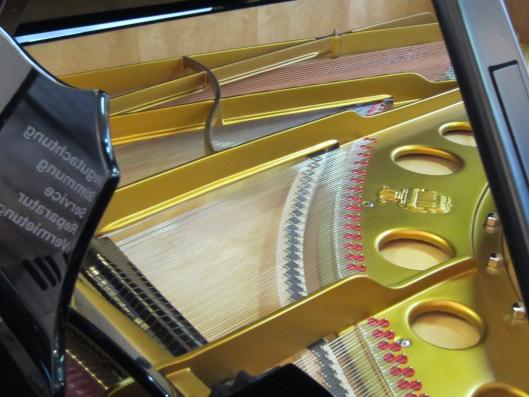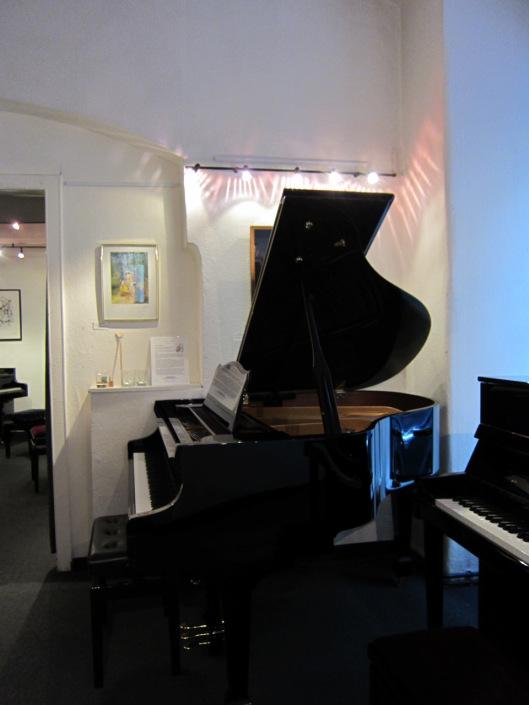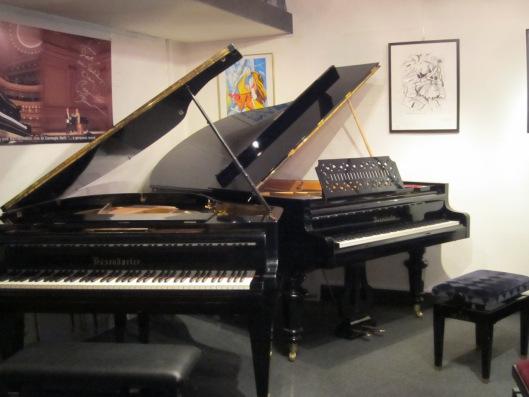
I had the recent good fortune to be introduced, through physicists, to Heinz Letuha and his incredible piano workshop, Die Klaviermachermeister. With a neat shopfront on Burggasse, the workshop sprawls through an old, sturdy Viennese building, huge piano shells wedged into tight hallways, hidden Steinhauser practice rooms tucked beside leafy courtyards, the workshop itself backing onto a cobblestoned side street.

While his shop houses some new pianos, his main business is to lovingly restore these stately old creatures, and many are close to a hundred years old, some older, most Austrian made. Each is an individual—grown to its own dimensions, housing a distinct metal heart of a harp frame all its own, and outwardly styled with deco trimmings or flourishes or wooden filigree. It’s incredible to see them disassembled; oversized puzzles, but so intricate and demanding such precision and attention.
We’re offered fresh Austrian mineral water, direct from the Alps through the taps (it is especially delicious), and we duck into the second room where Vienna’s preeminent boogie piano player happens to be hanging out. He gives us a little spiel; I have a little groove. Grand pianos are tucked into every corner, and we get to hear the distinct voices of them all—the more mellow and touch-responsive tones of a grand old lady next to the more jubilant and springy timbre of a youthful 1970s jazzy grand.

The workshop itself is flooded with the scent of glue and varnish, and dismembered keyboards are arranged on table tops, receiving individualised attention. A metal frame has just been re-lacquered. A case sits stripped of its innards down to its soundboard. We learn about the smallish pieces of hardwood that sit near the keyboard and that the strings are pegged into. This piano has had its peg-holes broadened a fraction so that newer, larger pegs can be fitted more snugly than the old wearing ones. This piece needs to be fitted so precisely, because it supports the metal harp frame across which the strings are strung—and when tuned, they put a vast number of tonnes of pressure across this frame. Incorrectly fitted, it can break, and danach ist deine Klavier kaputt.

We watch the little key mechanisms, see how they are fitted differently in an upright (there is a sliced piano in the window demonstrating just this, in fact), and inspect the density of the felts. One felt has been sliced down the middle, and it’s impossible to force back together. The immense pressure in every part of this instrument! The careful balance of heavy parts and huge tensions, all in search of the perfect sound. And so much of the work is down to the tonal abilities of the craftsman himself—he trickles out little scales to listen to the piano, like an attentive doctor listening to a heartbeat, detecting tiny imperfections with his naked ears, getting back in under the bonnet and making careful adjustments. He works just like an experienced painter who uses his eyes to make comparisons and detect the red in the blue, or the green of the yellow.

The passion for his craft sparkles in Heinz’s whole being, in his large eyes shining behind thick glasses, in the richly descriptive explanations that flow from his mouth, perfectly delivered—a performer keenly aware of his audience. It’s thrilling to meet someone so enamoured of this beautiful instrument, who has made it his whole life, who chases after perfection in every component, every material, in the way he reconstructs each one. It was an honor to meet such a craftsman. ‘When it comes from your heart, people see it and they respect that,’ he explains humbly.
